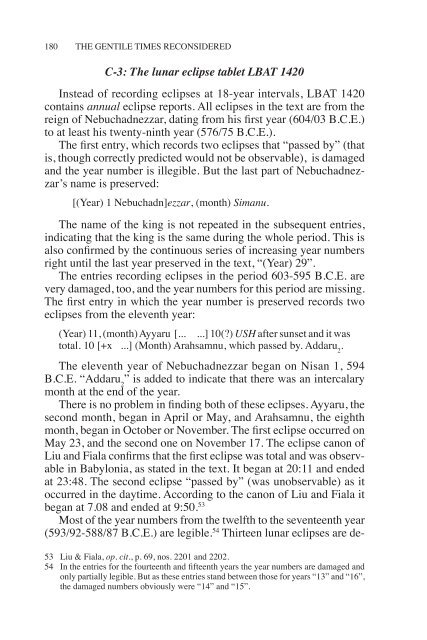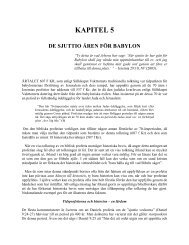4 the absolute chronology of the neo-babylonian era - Kristen Frihet
4 the absolute chronology of the neo-babylonian era - Kristen Frihet
4 the absolute chronology of the neo-babylonian era - Kristen Frihet
You also want an ePaper? Increase the reach of your titles
YUMPU automatically turns print PDFs into web optimized ePapers that Google loves.
180 THE GENTILE TIMES RECONSIDERED<br />
C-3: The lunar eclipse tablet LBAT 1420<br />
Instead <strong>of</strong> recording eclipses at 18-year intervals, LBAT 1420<br />
contains annual eclipse reports. All eclipses in <strong>the</strong> text are from <strong>the</strong><br />
reign <strong>of</strong> Nebuchadnezzar, dating from his first year (604/03 B.C.E.)<br />
to at least his twenty-ninth year (576/75 B.C.E.).<br />
The first entry, which records two eclipses that “passed by” (that<br />
is, though correctly predicted would not be observable), is damaged<br />
and <strong>the</strong> year number is illegible. But <strong>the</strong> last part <strong>of</strong> Nebuchadnezzar’s<br />
name is preserved:<br />
[(Year) 1 Nebuchadn]ezzar, (month) Simanu.<br />
The name <strong>of</strong> <strong>the</strong> king is not repeated in <strong>the</strong> subsequent entries,<br />
indicating that <strong>the</strong> king is <strong>the</strong> same during <strong>the</strong> whole period. This is<br />
also confirmed by <strong>the</strong> continuous series <strong>of</strong> increasing year numbers<br />
right until <strong>the</strong> last year preserved in <strong>the</strong> text, “(Year) 29”.<br />
The entries recording eclipses in <strong>the</strong> period 603-595 B.C.E. are<br />
very damaged, too, and <strong>the</strong> year numbers for this period are missing.<br />
The first entry in which <strong>the</strong> year number is preserved records two<br />
eclipses from <strong>the</strong> eleventh year:<br />
(Year) 11, (month) Ayyaru [... ...] 10(?) USH after sunset and it was<br />
total. 10 [+x ...] (Month) Arahsamnu, which passed by. Addaru 2<br />
.<br />
The eleventh year <strong>of</strong> Nebuchadnezzar began on Nisan 1, 594<br />
B.C.E. “Addaru 2<br />
” is added to indicate that <strong>the</strong>re was an intercalary<br />
month at <strong>the</strong> end <strong>of</strong> <strong>the</strong> year.<br />
There is no problem in finding both <strong>of</strong> <strong>the</strong>se eclipses. Ayyaru, <strong>the</strong><br />
second month, began in April or May, and Arahsamnu, <strong>the</strong> eighth<br />
month, began in October or November. The first eclipse occurred on<br />
May 23, and <strong>the</strong> second one on November 17. The eclipse canon <strong>of</strong><br />
Liu and Fiala confirms that <strong>the</strong> first eclipse was total and was observable<br />
in Babylonia, as stated in <strong>the</strong> text. It began at 20:11 and ended<br />
at 23:48. The second eclipse “passed by” (was unobservable) as it<br />
occurred in <strong>the</strong> daytime. According to <strong>the</strong> canon <strong>of</strong> Liu and Fiala it<br />
began at 7.08 and ended at 9:50. 53<br />
Most <strong>of</strong> <strong>the</strong> year numbers from <strong>the</strong> twelfth to <strong>the</strong> seventeenth year<br />
(593/92-588/87 B.C.E.) are legible. 54 Thirteen lunar eclipses are de-<br />
53 Liu & Fiala, op. cit., p. 69, nos. 2201 and 2202.<br />
54 In <strong>the</strong> entries for <strong>the</strong> fourteenth and fifteenth years <strong>the</strong> year numbers are damaged and<br />
only partially legible. But as <strong>the</strong>se entries stand between those for years “13” and “16”,<br />
<strong>the</strong> damaged numbers obviously were “14” and “15”.




